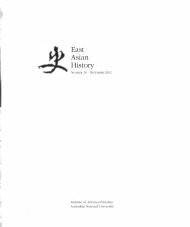Exhibiting Meiji Modernity: Japanese Art at the ... - East Asian History
Exhibiting Meiji Modernity: Japanese Art at the ... - East Asian History
Exhibiting Meiji Modernity: Japanese Art at the ... - East Asian History
- No tags were found...
Create successful ePaper yourself
Turn your PDF publications into a flip-book with our unique Google optimized e-Paper software.
86<br />
JUDITH SNODGRASS<br />
46 In his introductory essay to World's<br />
Columbian Exposition of 1893 Revisited,<br />
19th Century <strong>Japanese</strong> <strong>Art</strong> Shown in<br />
Chicago, US.A. (Umi 0 w<strong>at</strong><strong>at</strong>ta <strong>Meiji</strong> no<br />
bijutsu: saiken! 1993-nen Shikago Koronbusu<br />
Sekai Hakurankai: 1997.4.3-5.11)<br />
(Tokyo: Tokyo Kokuritsu Hakubutsukan,<br />
1997), Furuta Ry6 3E1l ~ describes <strong>the</strong><br />
n<strong>at</strong>ionwide call for exhibits. Never<strong>the</strong>less,<br />
work by members of <strong>the</strong> Tokyo School of<br />
Fine <strong>Art</strong>s predomin<strong>at</strong>ed, and among <strong>the</strong>m,<br />
those who had <strong>the</strong> distinction of being<br />
appointed to <strong>the</strong> Imperial Household list<br />
(Teishitsu Gigeiin 'i'if¥:tti'fl!7iJ Many were<br />
teachers <strong>at</strong> <strong>the</strong> school.<br />
47 Okakura Kakuz6, HoiJden: An Illustr<strong>at</strong>ed<br />
Description of <strong>the</strong> Buildings Erected by <strong>the</strong><br />
<strong>Japanese</strong> Government <strong>at</strong> <strong>the</strong> World's Columbian<br />
Exposition, Jackson Park, (Tokyo: n.p.,<br />
1893). The following description is taken<br />
from this pamphlet which is reproduced<br />
in Sunao Nakamura, ed. Okakura Kakuzo:<br />
Collected English Writings, 3 vols, (Tokyo:<br />
Heibonsha, 1984), vol.2, pp.5-29.<br />
48 Ibid. "N<strong>at</strong>ional" is his term and is emphasized<br />
in <strong>the</strong> original.<br />
49 Ibid., p.12. Rosenfield, "Nihonga," writes on<br />
<strong>the</strong> importance of "Heianism" in <strong>the</strong> work of<br />
<strong>the</strong> Tokyo School of Fine <strong>Art</strong>s. Following <strong>the</strong><br />
kokugaku studies of <strong>the</strong> Tokugawa period,<br />
<strong>the</strong> eleventh-century novel, Tale of Genji<br />
(Genji monog<strong>at</strong>ari im\.E\:;!Im~) by Murasaki<br />
Shikibu ~ rtW was regarded as "<strong>the</strong> unique<br />
expression of japanese sensibility", p.177.<br />
50 Okakura was to expand on <strong>the</strong>se <strong>the</strong>mes<br />
in Ideals of <strong>the</strong> <strong>East</strong>, establishing a basis for<br />
many of <strong>the</strong> stereotypical assumptions of<br />
<strong>the</strong> connections between Zen and japanese<br />
culture.<br />
51 For more on this, see Snodgrass, Presenting<br />
<strong>Japanese</strong> Buddhism to <strong>the</strong> West, p.38.<br />
consisted of three linked sections, each deliber<strong>at</strong>ely rel<strong>at</strong>ed to <strong>the</strong> epochmaking<br />
voyage of Columbus th<strong>at</strong> <strong>the</strong> Exposition celebr<strong>at</strong>ed. It had been<br />
designed by <strong>the</strong> government architect Kuru Masamichi J;z. WIEm, built in<br />
Japan using traditional methods and m<strong>at</strong>erials, and shipped to Chicago in<br />
numbered pieces where it was re-erected by <strong>Japanese</strong> craftsmen dressed<br />
in traditional costumes and using traditional tools. Its construction and<br />
dedic<strong>at</strong>ion were popular forms of entertainment with visitors; performances<br />
of pre-fair public rel<strong>at</strong>ions. The rooms contained some represent<strong>at</strong>ive<br />
antiques, but <strong>the</strong> interior decor<strong>at</strong>ion as a whole-<strong>the</strong> painted screens,<br />
walls, ceilings, and many of <strong>the</strong> objects on display-was designed and<br />
executed by <strong>the</strong> Tokyo School of Fine <strong>Art</strong>s. Since members of <strong>the</strong> School<br />
were also <strong>the</strong> major contributors to <strong>the</strong> Fine <strong>Art</strong>s exhibition, <strong>the</strong> Pavilion<br />
might be seen as an extension of <strong>the</strong> Fine <strong>Art</strong>s exhibition, one th<strong>at</strong><br />
displayed <strong>Japanese</strong> art in its cultural context. 46 The work of <strong>the</strong> School<br />
ensured th<strong>at</strong> <strong>the</strong> Pavilion was not simply a historical exhibition of Japan's<br />
past achievement but a display of <strong>the</strong> present skill and artistic vitality of<br />
<strong>Meiji</strong> Japan. The messages it embodied informed <strong>the</strong> <strong>Japanese</strong> exhibit as a<br />
whole. Okakura spelled <strong>the</strong>se out in a pamphlet distributed <strong>at</strong> <strong>the</strong> fair. 47<br />
The north wing was built in <strong>the</strong> style of <strong>the</strong> Fujiwara ~JJj( period<br />
(897-1185) a time when Japan, isol<strong>at</strong>ed from continental influence,<br />
developed a distinctively " n<strong>at</strong>ional" art in contrast to <strong>the</strong> continental ideas<br />
of preceding epochs. 48 It was furnished with objects of high culture, learning<br />
and sophistic<strong>at</strong>ion suggesting a refined era when "<strong>the</strong> aristocracy ...<br />
was occupied with <strong>the</strong> exchange of visits; musical and poetic g<strong>at</strong>herings<br />
and o<strong>the</strong>r amusements".49 This wing established <strong>the</strong> antiquity of <strong>Japanese</strong><br />
civiliz<strong>at</strong>ion, <strong>the</strong> st<strong>at</strong>e of <strong>Japanese</strong> culture 400 years before Columbus<br />
arrived in <strong>the</strong> Americas. The south wing was in <strong>the</strong> Ashikaga JE.5f1j<br />
0233-1568), style reproducing rooms from <strong>the</strong> Silver Pavilion (Ginkakuji<br />
&.&OO~) built in Kyoto in 1497. One room was a library; <strong>the</strong> o<strong>the</strong>r furnished<br />
for <strong>the</strong> tea ceremony. Toge<strong>the</strong>r <strong>the</strong>y showed "<strong>the</strong> part played<br />
by Buddhism in restoring <strong>the</strong> tranquil st<strong>at</strong>e of mind to <strong>the</strong> people". The<br />
Ashikaga period was characterized by its refined taste. 50 Paintings by <strong>the</strong><br />
iconic <strong>Japanese</strong> landscape artist Sesshu §f} 0420- 1506)- a contemporary<br />
of Columbus-were prominently displayed. The central section was<br />
a replica of rooms from Edo rIP castle <strong>at</strong> <strong>the</strong> height of Tokugawa :f!J II<br />
power, and represented <strong>Japanese</strong> culture <strong>at</strong> <strong>the</strong> time of <strong>the</strong> intrusion of <strong>the</strong><br />
American fleet under Commodore Perry and <strong>the</strong> subsequent imposition<br />
of <strong>the</strong> unequal tre<strong>at</strong>ies. Reference to <strong>the</strong> tre<strong>at</strong>ies and Japan's expect<strong>at</strong>ion<br />
of favourable renewal was explicitly made <strong>at</strong> <strong>the</strong> dedic<strong>at</strong>ion of <strong>the</strong> building.<br />
51 While <strong>Japanese</strong> may have been willing to concede th<strong>at</strong> America had<br />
hastened <strong>the</strong>ir entry into industrial modernity, <strong>the</strong>se rooms challenged<br />
any notion th<strong>at</strong> <strong>the</strong> United St<strong>at</strong>es had brought civiliz<strong>at</strong>ion to barbarians.<br />
Japan had been "cultured" centuries before America was even an idea
















